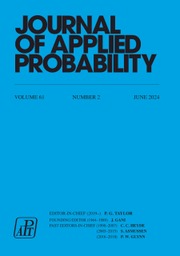Article contents
A relation between positive dependence of signal and the variability of conditional expectation given signal
Published online by Cambridge University Press: 14 July 2016
Abstract
Let S 1 and S 2 be two signals of a random variable X, where G 1(s 1 ∣ x) and G 2(s 2 ∣ x) are their conditional distributions given X = x. If, for all s 1 and s 2, G 1(s 1 ∣ x) - G 2(s 2 ∣ x) changes sign at most once from negative to positive as x increases, then the conditional expectation of X given S 1 is greater than the conditional expectation of X given S 2 in the convex order, provided that both conditional expectations are increasing. The stochastic order of the sufficient condition is equivalent to the more stochastically increasing order when S 1 and S 2 have the same marginal distribution and, when S 1 and S 2 are sums of X and independent noises, it is equivalent to the dispersive order of the noises.
MSC classification
Information
- Type
- Short Communications
- Information
- Copyright
- © Applied Probability Trust 2006
References
- 6
- Cited by

